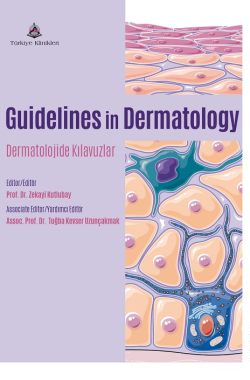ALOPECIA AREATA
Özge Aşkın1
Sezer Özdil2
1İstanbul University-Cerrahpaşa, Cerrahpaşa Faculty of Medicine, Department of Dermatology, İstanbul, Türkiye
2İstanbul University-Cerrahpaşa, Cerrahpaşa Faculty of Medicine, Department of Dermatology, İstanbul, Türkiye
Aşkın Ö, Özdil S. Alopecia Areata. In: Kutlubay Z, editor. Guidelines in Dermatology. 1st ed. Ankara: Türkiye Klinikleri; 2025. p.15-22.
ABSTRACT
Alopecia areata is a challenging condition in dermatology as it is a chronic inflammatory disease that causes non-scarring hair loss. This guideline provides a comprehensive overview of different treatment strategies, including both local and systemic approaches. The Severity of Alopecia Tool (SALT) score is an assessment of disease severity which can be helpful for treatment decision. The risk-benefit profile, disease severity, and patient characteristics guide the choice between local and systemic treatments. Local treatments include intralesional corticosteroids, topical corticosteroids, topical immunotherapy with diphenylcyclopropenone (DPCP) or squaric acid dibutyl ester (SADBE), topical irritants such as anthralin and topical minoxidil. Systemic treatments include systemic corticosteroids, immunosuppressants such as methotrexate, cyclosporine, and sulfasalazine, and Janus Kinase (JAK) inhibitors like oral baricitinib, ritlecitinib, and tofacitinib. Baricitinib and ritlecitinib was approved by both the FDA and the EMA for the treatment of alopecia areata. It is important to screen and monitor patients receiving systemic treatments due to potential adverse effects. This guideline discusses the contraindications and precautions of treatments, emphasizing the need for caution in specific patient populations. And it aims to help clinicians optimise patient care by providing a comprehensive understanding of available treatments.
Keywords: Alopecia areata; Biological treatment; Disease severity; Systemic treatments; Topical treatments
Kaynak Göster
Referanslar
- Cervantes J, Fertig RM, Maddy A, Tosti A. Alopecia Areata of the Beard: A Review of the Literature. Am J Clin Dermatol. 2017 Dec;18(6):789-796 [Crossref] [PubMed]
- Olsen EA, Hordinsky MK, Price VH, et al. Alopecia areata investigational assessment guidelines--Part II. National Alopecia Areata Foundation. J Am Acad Dermatol 2004; 51: 440-447. [Crossref] [PubMed]
- Alkhalifah A, Alsantali A, Wang E, McElwee KJ, Shapiro J. Alopecia areata update: part II. Treatment. J Am Acad Dermatol. 2010 Feb;62(2):191-202, quiz 203-4. [Crossref] [PubMed]
- Andrew G. Messenger, Rodney D. Sinclair, Paul Farrant DAR de B. Alopecia areata. In: Griffiths C, Barker J, Bleiker T, Robert Chalmers DC, editors. Rook's Textbook of Dermatology. 9th ed. Oxford: Wiley‐Blackwell; 2016: 2265-2342.
- Barton VR, Toussi A, Awasthi S, Kiuru M. Treatment of pediatric alopecia areata: A systematic review. J Am Acad Dermatol. 2022 Jun;86(6):1318-1334. [Crossref] [PubMed] [PMC]
- Messenger AG, McKillop J, Farrant P, McDonagh AJ, Sladden M. British Association of Dermatologists' guidelines for the management of alopecia areata 2012. Br J Dermatol. 2012 May;166(5):916-26. [Crossref] [PubMed]
- Garg S, Messenger AG. Alopecia areata: evidence-based treatments. Semin Cutan Med Surg. 2009 Mar;28(1):15-8. [Crossref] [PubMed]
- Fiedler-Weiss VC. Topical minoxidil solution (1% and 5%) in the treatment of alopecia areata. J Am Acad Dermatol. 1987 Mar;16(3 Pt 2):745-8. [Crossref] [PubMed]
- Sterkens A, Lambert J, Bervoets A. Alopecia areata: a review on diagnosis, immunological etiopathogenesis and treatment options. Clin Exp Med. 2021 May;21(2):215-230. [Crossref] [PubMed]
- Phan K, Ramachandran V, Sebaratnam DF. Methotrexate for alopecia areata: A systematic review and meta-analysis. J Am Acad Dermatol. 2019 Jan;80(1):120-127.e2. [Crossref] [PubMed]
- Nowaczyk J, Makowska K, Rakowska A, Sikora M, Rudnicka L. Cyclosporine With and Without Systemic Corticosteroids in Treatment of Alopecia Areata: A Systematic Review. Dermatol Ther (Heidelb). 2020 Jun;10(3):387-399. [Crossref] [PubMed] [PMC]
- Ellis CN, Brown MF, Voorhees JJ. Sulfasalazine for alopecia areata. J Am Acad Dermatol. 2002 Apr;46(4):541-4. [Crossref] [PubMed]
- Welsh O. Phototherapy for alopecia areata. Clin Dermatol. 2016 Sep-Oct;34(5):628-32. [Crossref] [PubMed]
- Bayramgürler D, Demirsoy EO, Aktürk AŞ, Kiran R. Narrowband ultraviolet B phototherapy for alopecia areata. Photodermatol Photoimmunol Photomed 2011; 27: 325-327. [Crossref] [PubMed]
- Al-Mutairi N. 308-nm excimer laser for the treatment of alopecia areata in children. Pediatr Dermatol 2009; 26: 547-550. [Crossref] [PubMed]
- Olumiant (baricitinib) tablets, for oral use. US FDA approved product information; Indianapolis, IN: Eli Lilly and Company; July 2020 [Link]
- King B, Ohyama M, Kwon O, Zlotogorski A, Ko J, Mesinkovska NA, Hordinsky M, Dutronc Y, Wu WS, McCollam J, Chiasserini C, Yu G, Stanley S, Holzwarth K, DeLozier AM, Sinclair R; BRAVE-AA Investigators. Two Phase 3 Trials of Baricitinib for Alopecia Areata. N Engl J Med. 2022 May 5;386(18):1687-1699. [Crossref] [PubMed]
- US Food and Drug Administration. FDA requires warnings about increased risk of serious heart-related events, cancer, blood clots, and death for JAK inhibitors that treat certain chronic inflammatory conditions. [Link]
- King B, Zhang X, Harcha WG, Szepietowski JC, Shapiro J, Lynde C, Mesinkovska NA, Zwillich SH, Napatalung L, Wajsbrot D, Fayyad R, Freyman A, Mitra D, Purohit V, Sinclair R, Wolk R. Efficacy and safety of ritlecitinib in adults and adolescents with alopecia areata: a randomised, double-blind, multicentre, phase 2b-3 trial. Lancet. 2023 May 6;401(10387):1518-1529 https://pubmed.ncbi.nlm.nih.gov/37062298/ [Crossref] [PubMed]
- Litfulo (ritlecitinib) [prescribing information]. New York, NY: Pfizer; June 2023. [Link]
- Liu LY, Craiglow BG, Dai F, King BA. Tofacitinib for the treatment of severe alopecia areata and variants: A study of 90 patients. J Am Acad Dermatol. 2017 Jan;76(1):22-28. [Crossref] [PubMed]
- Jakafi (ruxolitinib) [prescribing information]. Wilmington, DE: Incyte Corporation; January 2023. [Link]
- Mackay-Wiggan J, Jabbari A, Nguyen N, Cerise JE, Clark C, Ulerio G, Furniss M, Vaughan R, Christiano AM, Clynes R. Oral ruxolitinib induces hair regrowth in patients with moderate-to-severe alopecia areata. JCI Insight. 2016 Sep 22;1(15):e89790. [Crossref] [PubMed] [PMC]
- Olsen EA, Kornacki D, Sun K, Hordinsky MK. Ruxolitinib cream for the treatment of patients with alopecia areata: A 2-part, double-blind, randomized, vehicle-controlled phase 2 study. J Am Acad Dermatol. 2020 Feb;82(2):412-419 [Crossref] [PubMed]
- Liu LY, Craiglow BG, King BA. Tofacitinib 2% ointment, a topical Janus kinase inhibitor, for the treatment of alopecia areata: A pilot study of 10 patients. J Am Acad Dermatol. 2018 Feb;78(2):403-404.e1. [Crossref] [PubMed]
- Putterman E, Castelo-Soccio L. Topical 2% tofacitinib for children with alopecia areata, alopecia totalis, and alopecia universalis. J Am Acad Dermatol. 2018 Jun;78(6):12071209.e1. [Crossref] [PubMed]

